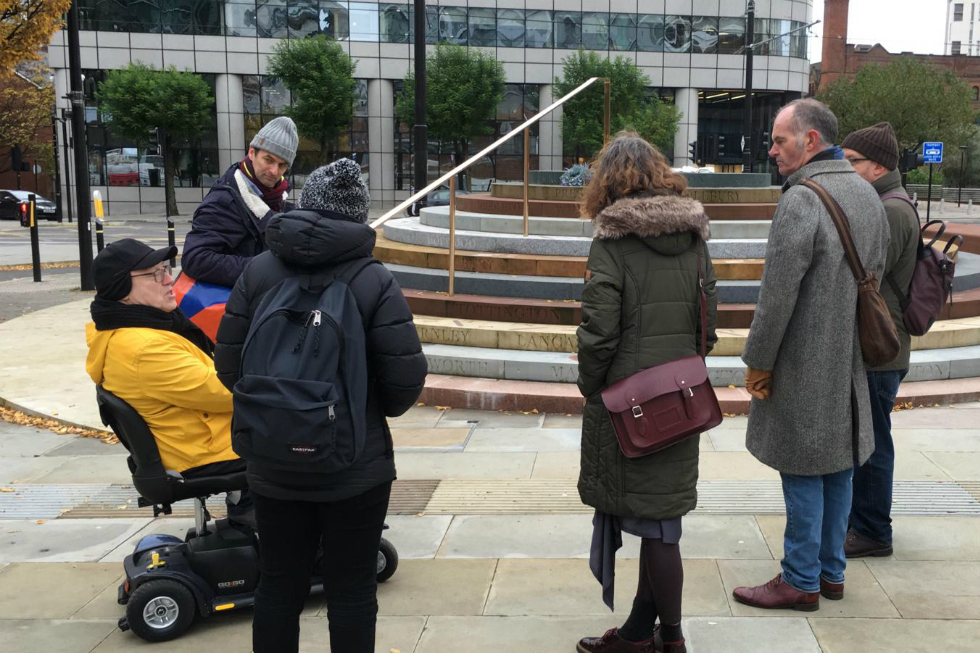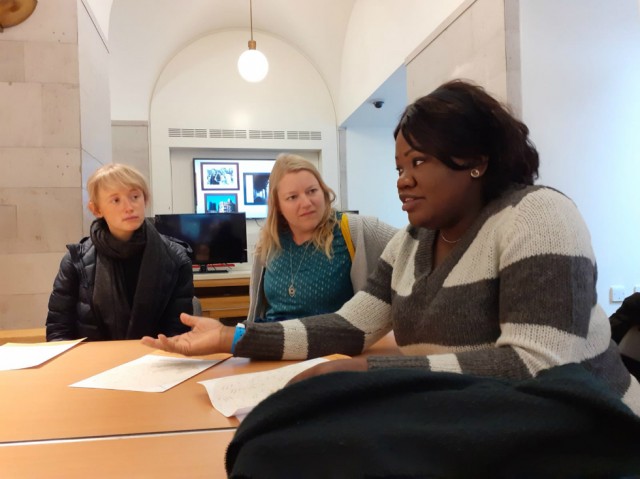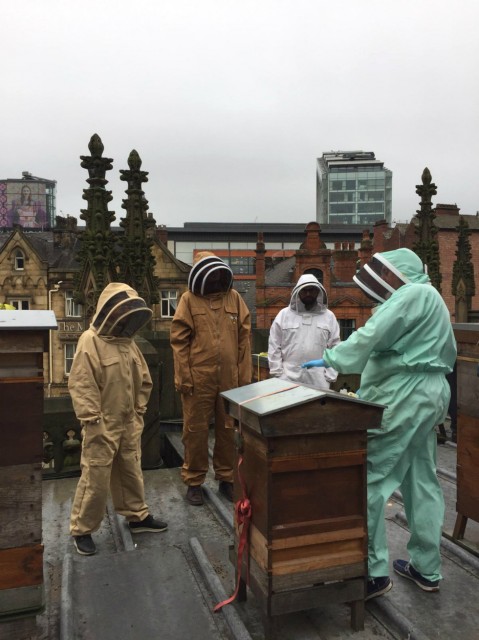Who is the city for? – Sara Jaspan Meets The Neighbours

With asylum seekers moved out of increasingly exclusive city centres and affordable housing targets going unmet, Sara Jaspan reports on an artists’ project engaging with the changing face of developing neighbourhoods…
“I felt safe here,” Évelyn Mbuluku told us as we sat in Manchester Central Library. It’s warm, the seats are comfy, there’s free WiFi, plug sockets to charge your phone, security staff (though they move you on if you fall asleep, which is forbidden), and most importantly, it’s one of the few spaces you can just be without having to buy anything.
A small group of strangers is being led on a walking tour of Manchester city centre at the start of a two-day long event organised by Quarantine theatre company (behind the MIF17 opening ceremony, What is the City but the People?) and curator Florian Malzacher. The tour focuses on the places that hold most significance for Mbuluku and her friend Barly Koyangbwa, both asylum seekers who fled to the UK from DR Congo in 2014. They recount the protracted struggle of the last five years – of navigating the Home Office system alongside periods of homelessness and destitution. Mbuluku’s application has now been accepted; Koyangbwa is still waiting to discover his fate.
Other stops along the route include the Manchester Tribunal Hearing Centre, which rejected Mbuluku’s application on several occasions and she often makes long detours to avoid; Mustard Tree, where she and Koyangbwa exchange vouchers for food and basic necessities; the Friends’ Meeting House, where they connected with The Boaz Trust, a charity that works with asylum seekers and refugees in Greater Manchester; and Manchester Art Gallery, where briefly sharing their skills with others as part of the Tania Bruguera Manchester International Festival 2019 School of Integration project made them feel like they existed.
The tour was one of thirteen simultaneously taking place as part of Meet the Neighbours: The Weekend (9–10 November), each offering a different perspective on the city based on the various guides’ unique relationship with it. The public programme marked the close of a three-year-long international project (itself called Meet the Neighbours) that invited artists into the heart of five rapidly developing neighbourhoods around the world to reflect on the changes taking place.

Afterwards, convening at Sacha’s Hotel in Manchester’s Northern Quarter, people exchanged accounts of their journeys while waiting for the next part of the day to unfold. Some had found themselves on a walk round the perimeter of Strangeways Prison, exploring wealth, development, crime and poverty in the area. Others were taken on a visit to the Urban Splash development transforming New Islington by the company’s marketing director. One group experienced the city from the perspective of a wheelchair user. Another was introduced to the 50,000 resident bees living on the roof of Manchester Cathedral. Another still met Peggy Kynaston – thought to be the city centre’s ‘longest serving’ resident – who welcomed them into her flat and shared stories of how the area has changed over the 39 years that she’s lived there.
In 1981, fewer than 600 people lived in the heart of Manchester. Now, the number is placed at 65,000 and continues to rise. During this forty-year period, significant urban regeneration has transformed the city from one of post-industrial decline into the so-called ‘economic boomtown’ and magnet for foreign investment it is today. Yet this process of rapid, profit-driven transformation has not benefited everyone equally (disproving the trickle-down narrative). While towering luxury apartment blocks have started to crowd the skyline, the council is woefully failing to enforce its policy of 20% affordable housing in all new developments (as highlighted by the Guardian’s Oliver Wainwright). Furthermore, Manchester’s homeless population is the highest in the north of England; and despite 13,500 households being on the list for social housing, just 1% of new homes built last year met this need (according to a 2019 report by homelessness and housing charity, Shelter).
Development of this kind is leading to central areas of the city becoming exclusively for the well-off, where any form of neighbourliness occurs within a safe bubble of homogeneity. (Some new ventures – branded as ‘luxury lifestyle concepts’ – offer an app-based service that orchestrates socialising opportunities among residents; a commodified and enclosed version of community.) Despite having lived in the city centre for the last five years and gradually developing an important network of friends there, like many in similar situations, Mbuluku and Koyangbwa have both finally been housed elsewhere, out of town. Koyangbwa recounts being told by the housing services that he had no need to travel into Manchester; he had a Tesco down the road.
All this begs the overarching question of the weekend: Who is the city for?
Moving from the faded glamour of the hotel lobby into one of its large conference rooms (dotted with tents in reference to Manchester’s many homeless camps), the rest of the day opened with a keynote speech by Belgian artist Sarah Vanhee, who took part in Quarantine’s ‘Tenancy’ project (2018-19) – the UK strand of Meet the Neighbours. Tenancy invited artists to take up residence in one of the Swedish-style new-builds that form part of the Urban Splash Irwell Riverside development on the border of Manchester and Salford – a recently established neighbourhood literally surrounded by a fence, with limited interaction with the nearby pre-existing streets. Vanhee reflected on her reservations at the start of her stay, not wanting to be “the well-meaning artist who simply turns up for a short period and decides everyone should become good friends”.

This wasn’t Quarantine’s intention for the project either. Speaking to the company’s artistic director, Richard Gregory, the aim was to examine the state of neighbourliness in our cities today, not to engineer it. (The second day of the weekend was themed around the shifting place of artists in cities and art as a form of social action.)
Vanhee’s speech – which outlined her own vision of good-neighborship, based on a careful negotiation of letting one another be while not being indifferent – was followed by a series of Encounters: thirteen stations throughout the room where artists, activists, urban designers and others, including a professional psychic, led hands-on activities, mini-lectures and round-table discussions. Each was designed to generate debate around the politics of rapid urban development, the kind of city people want to live in, and the potential for citizens to shape Manchester’s future. These were punctuated by several brief interventions from figures including Aditya Chakrabortty (senior economics commentator at the Guardian) and Dr. Ransford A. Acheampong (from the Manchester Urban Institute), who presented their imagined accounts of the city from the perspective of 2029 in the style of live video dispatches.
The themes covered during this second part of the afternoon ranged widely, from the need to also plan for Manchester’s animal and insect population as part of its development, for more community gardens, and for better transport links rather than more car parks; through to the causes of and possible solutions to the UK’s housing crisis, and the politics of private investment. Conversations were enriched by the presence of people from different sides of the urban regeneration debate and members of the public, though the level of diversity in the room did seem to some extent limited. The day ended with a shared meal and Noisy Neighbours, an evening of live Manchester-based music.
Returning to Mbuluku and Koyangbwa, one thing that struck me was their account of how taken aback they were at finding themselves welcome in such a ‘posh’ place as the city’s Central Library; somewhere others might take for granted (and to which homeless people and protesters were controversially denied access for a period in 2015). Do we want to live in a city where ‘welcome to all’ is a rare exception to the rule? A city organised around capital rather than citizens? As Manchester’s great reinvention marches on, we need to consider what part neighbourliness plays within it. As Shakespeare asked in Coriolanus, and Quarantine asked again from a catwalk in Piccadilly Gardens four centuries later: What is the city but the people?
Sara Jaspan
Images, from top: Mark Todd showing the Peterloo monument to walkers and its lack of access for disabled people in his tour of the city; Some of the city’s asylum seekers; The bees on the roof of Manchester cathedral.





